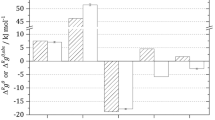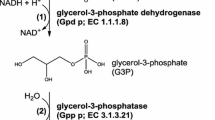Abstract
Control Analysis has been carried out in the first steps of a rat liver glycolytic system. Attention has been focused on the effect of several glucose concentrations on the control, particularly regarding the role of glucokinase. From kinetic studies of the whole metabolic system we have obtained information on the flux variation under different glucose concentrations. This information together with the kinetics of glucokinase has allowed us to calculate Flux Control and Elasticity Coefficients for glucokinase and the Response Coefficient of the system with respect to glucose. The changes in of the value of Flux Control Coefficients demonstrates that in conditions of low glucose concentration, glucokinase is the main enzyme in controlling the flux through the pathway, but at high glucose concentration the control moves to phosphofructokinase. Next, we have compared our results with those obtained with the shortening and titration method, previously described (Torres, N.V., Mateo, F., Mélendez-Hevia, E. and Kacser, H., (1986) Biochem. J. 234, 169–174; Torres, N.V. and Meléndez-Hevia, E. 1991. Molec. Cell. Biochem. 101, 1–10). Furthermore, from knowledge of the enzyme kinetics of the system we have been able to build a model of the pathway that allows us computer similation of its behavior and calculation of the Flux Control Coefficient profile at different glucose concentrations. By the three methods the results correlate, supporting the use of the pathway substrate as external modulator of the metabolic system as a tool for practical application of Control Analysis.
Similar content being viewed by others
References
Kacser H, Burns JA: The control of flux. Symp Soc Exp Biol 27: 65–104, 1973
Heinrich R, Rapoport TA: A linear steady state treatment of enzymatic chains. General properties. Control and effector stregth. Eur J Biochem 42: 89–95, 1974
Kacser H, Burns JA: Molecular Democracy: Who shares the controls? Biochem Soc Trans 7: 1149–1160, 1979
Flint HJ, Tateson RW, Barthelmess IB, Porteous DS, Donachie WD, Kacser H: Control of the flux in the Arginine pathway of Neurospora Crassa. Biochem J 200: 231-246
Rapoport TA, Heinrich R, Rapoport S: The regulatory principles of glycolysis in eritrocyte in vivo and in vitro. A minimal comprehensive model describing steady states, quasi-steady state and time dependent processes. Biochem J 154: 449–469, 1976
Kohn MC, Chiang E: Sensitivity to Values of Rate constants in a Neurochemical Metabolic Model. J Theor Biol 100: 551–565, 1983
Canela EI, Ginesta I, Franco R: Simulation of the purine nucleotide cycle as an anplerotic process in skeletal muscle. Arch Biochem Biophys 254: 142–155, 1987
Torres NV, Mateo F, Sicilia J, Meléndez-Hevia E: Distribution of the flux control in convergent metabolic pathways: theory and application to experimental and simulated systems. Int J Biochem 20: 161–165, 1988
Groen AK, Wanders RJA, Westerhoff HV, Van der Meer R, Tager JM: Control of metabolic fluxes. In Metabolic Compartimentation. (Edited by Sies, H), Academic Press, New York, 1982, pp 9–37
Groen AK, Wanders RJA, Westerhoff HV, Van der Meer R, Tager JM: Quantification on the contribution of various steps to the control of mitochondrial respiration. J Biol Chem 257: 2754–2757, 1982
Salter M, Knowles R, Pogson CI: Quantification on the importance of individuals steps in the control of aromatic amino acid metabolism. Biochem J 234: 635–647, 1986
Fell DA, Sauro H: Metabolic control and its analysis. Eur J Biochem 148: 555–561, 1985
Fell DA, Snell K: Control analysis of mammalian serine biosynstesys. Feedback inhibition on the final steps. Biochem J 256: 97–101, 1988
Cascante M, Torres NV, Franco R, Meléndez-Hevia E, Canela EL Control analysis of transition times. Extension of analysis and matrix method. Mol Cell Biochem 101: 83–91, 1991
Torres NV, Mateo F, Meléndez-Hevia E, Kacser H: Kinetics of metabolic pathways. A system in vitro to study the control of flux. Biochem J 234: 169–174, 1986
Meléndez-Hevia E, Torres NV: Determination of Control Coefficients by shortening and enzyme titration of metabolic pathways. In Control of Metabolic Processes (A Cornish-Bowden, ML Cárdenas, (eds.) NATO ASI Series. Plenum Press, New York, 1990. pp 231–238
Torres NV, Meléndez-Hevia E: Detailed protocol and critical view for the analysis of control in metabolic systems by shortening and enzyme titration. Molec Cell Biochem 101: 1–10, 1991
Torres NV, Mateo F, Meléndez-Hevia E: Shift in rat liver glycolysis control from fed to starved conditions. Flux control coefficients of glucokinase and phosphofructokinase. FEBS Lett 233: 83–86, 1988
Torres NV, Mateo F, Riol-Cimas JM, Meléndez-Hevia E: Control of glycolysis in rat liver by glucokinase and phosphofructokinase: influence of glucose concentration. Mol Cell Biochem 93: 21–26, 1990
Racker E: Transketolase and Transaldolase, in ‘Enzymes’. PD Boyer, HA Lardy, K Myrbaeck (eds.) 2th edn. Vol 5. 397-412, 1962
Mahler HR, Cordes EH: Biological Chemistry, 1st edn. pag 420, Harper, New York, 1969
Newsholme EA, Start C: Regulation in Metabolism. Wiley, Interscience, London, 1973
Pilkis SJ: Glucokinase of rat liver. In Methods in Enzymology. Vol XLII Part C pp 31–39, 1975
Castaño JG, Nieto A, Feliú JE: Inactivation of phosphofructokinase by glucagon in rat liver. J Biol Chem Vol 254, 13: 5576–5579, 1979
Alberty RA: The rate equation for an enzymatic reaction. In The Enzymes, Vol 1. Ed. By Boyer, Lardy and Myrback. New York, 1959. Academic Press
Sauro HM: Control analysis and simulation of metabolism. Doctoral Thesis. Oxford Polytechnic, 1987
Hers HG, Hue L: Gluconeogenesis and related aspects of glycolysis. Ann Rev Biochem 52: 617–653, 1983
Hers H-G, Van Schaftingen E: Fructose 2,6-biphosphate 2 years after its discovery. Biochem J 206: 1–12, 1982
Torres NV: (1985) Doctoral Thesis. Universidad de La Laguna
Reich JG, Sel'kov EE: Energy Metabolism of the Cell. Academic Press, Inc. London, 1981
Lathela JT, Wals PA, Katz J: Glucose metabolism and recycling by hepatocytes of OB/OB and ob/ob (obese diabetic) mice. Am J Physiol 259: E389-E396, 1990
Author information
Authors and Affiliations
Rights and permissions
About this article
Cite this article
Meléndez-Hevia, E., Mateo, F. & Torres, N.V. Control analysis of rat liver glycolysis under different glucose concentrations. The substrate approach and the role of glucokinase. Mol Cell Biochem 115, 1–9 (1992). https://doi.org/10.1007/BF00229089
Received:
Accepted:
Issue Date:
DOI: https://doi.org/10.1007/BF00229089




